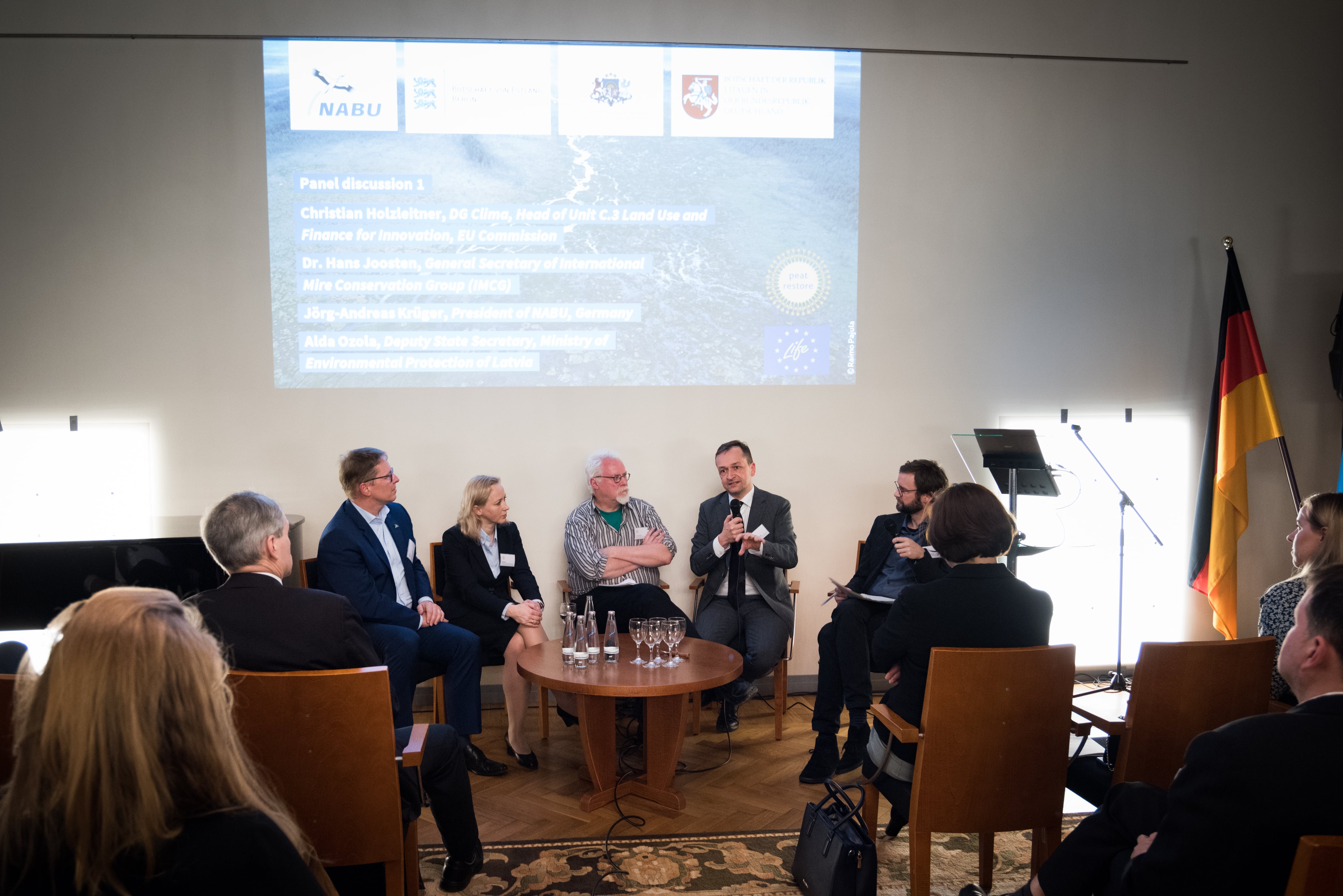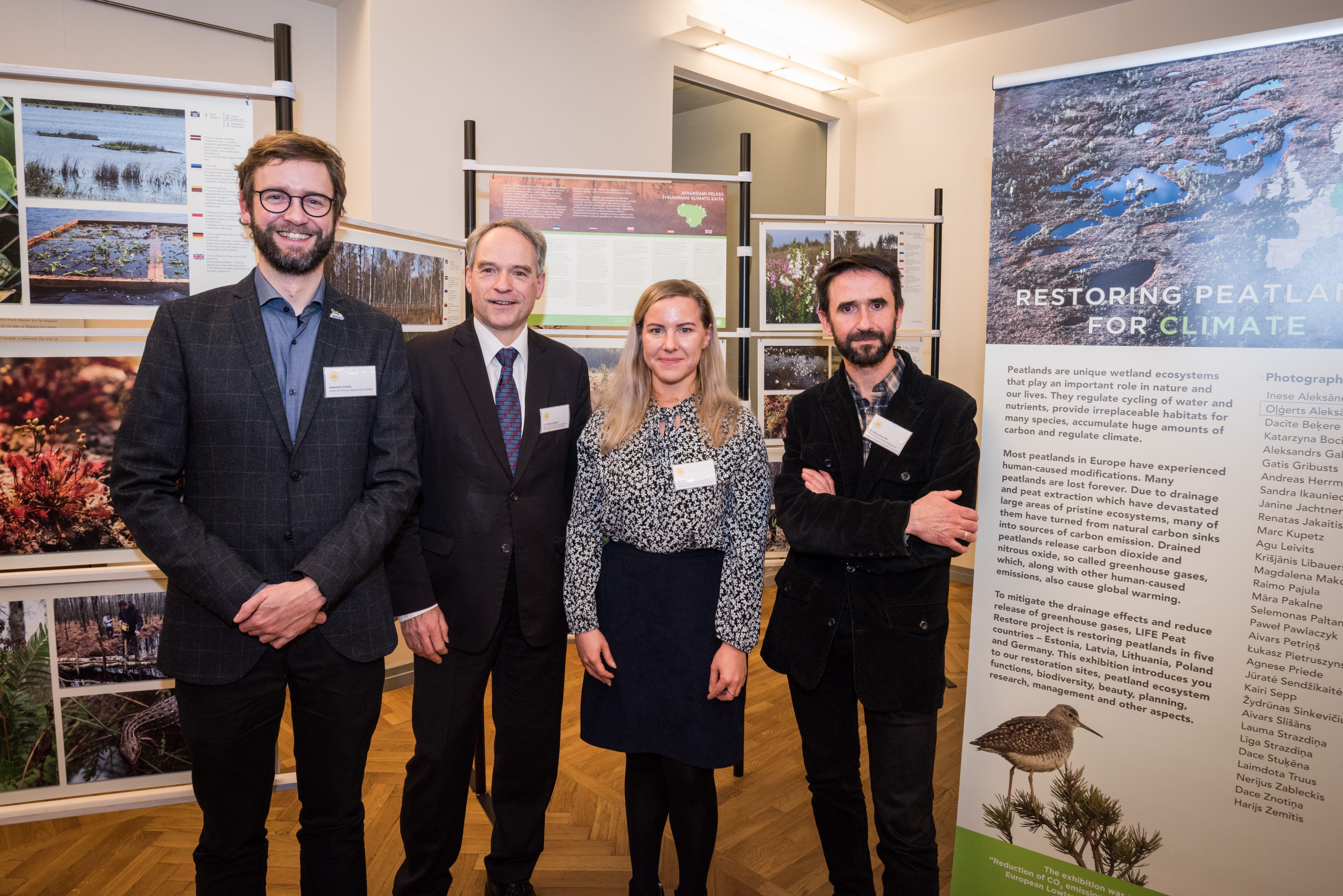Everybody’s talking about trees. But on a global scale, peatlands, if they are still intact, store more carbon than all the forests on earth put together. Peatlands obviously have an image problem. This is something that is on the minds of many people who have come to the Estonian Embassy in Berlin on 15 January: more than 90 experts from science, politics and nature conservation participate in the panel discussions “Restoring Peatlands for Climate”. Some have notepads on their laps. Full of anticipation, they are waiting for the speeches and panel discussions to begin. But first of all, Alar Streimann, the Estonian Ambassador, gives them a warm welcome.
What can and must we do to preserve intact peatlands and restore destroyed ones? What is necessary to enable them to remove carbon from the atmosphere effectively and sustainably again? How can we manage to stop peat usage? And how can we solve the image problem of peatlands? These questions are at the heart of this very well-attended event. There’s hardly an empty seat to be seen, a fact partly explained by the presence of Hans Joosten, professor of peatland studies and palaeoecology. Professor Joosten is preeminent in his field. Hardly anyone is able to talk as passionately and comprehensively about the fascinating characteristics of peatlands and peat – a topic that usually makes the general public think of mud and will-o’-the-wisps.
Pickled gherkin water: that’s the stuff
There is a sense of excitement and concentration in the air, as Professor Hans Joosten points to a jar of gherkins appearing in the power point presentation behind him. Joosten explains: “Peatlands are like pickled gherkins: When you remove the conserving water, the organic matter rots. It’s like that with peatlands as well.” Many audience members are familiar with this problem. If water is drained from peatlands – the most effective carbon sinks to be found on our planet – the peat, which has often accumulated there for thousands of years, gets exposed to oxygen and starts to rot. Huge quantities of the greenhouse gases CO2 and N2O escape into the atmosphere – amounts so large that drained peatlands significantly contribute to global warming. Across the world, the greenhouse gases these drained peatlands emit equal two gigatons of CO2 every year. Indonesia is the largest emitter: “But, and that is often forgotten: the European Union follows just behind, ranking second”, Joosten says.
This is why NABU is currently working with eight partners on the project “LIFE Peat Restore” to ensure that eleven peatland areas, spanning a total of 5,300 hectares in Germany, Poland, Lithuania, Latvia and Estonia, are rewetted. The bottom line of the Paris Agreement is that the countries of the EU have to be climate neutral by the year 2050. To achieve this goal, we have to rewet 150,000 square kilometres of peatlands, 5,000 square kilometres per year. Joosten exudes an incredible sense of energy, spurring the audience into action. His message could hardly be clearer: The peatlands have to be rewetted to protect our climate, our planet and the basis of human life, forever…
Going out into the field, seeking dialogue
Joosten’s optimistic attitude is infectious, but it does not conceal the actual practical challenges lying ahead. This is about peatland conservation in the field, in the most literal sense. The main reason for the drainage of peatlands is intensive agriculture. At the moment, there are hardly any economic incentives for farmers to stop using peatlands or adapt their methods. How can they be convinced that this is necessary? Not by handing out extensive draft papers to them, stresses NABU’s president Jörg-Andreas Krüger during the first panel discussion: “No, we have to go into the regions and talk to the farmers and convince them of nature-friendly alternatives”, says Krüger. It is important to change the EU subsidy scheme and the out-of-date logic behind it, he argues. This is an appeal to the representative of the EU Commission, Christian Holzleitner. Other international government representatives have come as well, among them Alda Ozola, deputy state secretary at the Ministry of Environmental Protection and Regional Development in Latvia.

Photo: NABU / S.Hennigs
Insights gained
There is bound to be some controversy when different interest groups meet to discuss such a complex topic. What is surprising, though, is how many central aspects Joosten, Krüger, Ozala and Holzleitner, as well as the participants of the second panel discussion, agree on.
Today the role of peatlands as carbon sinks is more important than ever. Restoring peatlands is absolutely necessary to achieve the climate objectives of the Paris Agreement. “We have had the necessary knowledge and the methods to rewet drained peatlands for a long time. But the EU subsidy scheme for land use has to be changed urgently”, stress the participants of the panel discussion. In addition, projects like “LIFE Peat Restore” need to reach a wider public so that more companies become aware of sustainable means of land use and, much more importantly, put these into practice themselves.
After just over two hours of inspiring discussions, we must now focus on the core messages of the evening and translate these into real conservation work. To return to Joosten’s metaphor: The best gherkins are the ones you eat straight from the jar – crisp, fresh, and full of moisture, just like rewetted peatlands.

Photo: NABU / S.Hennigs
Background
How can we restore peatlands and stop peat usage to protect our climate? The panel discussion “Restoring peatlands for climate” took place at the Estonian Embassy on 15 January 2020.


